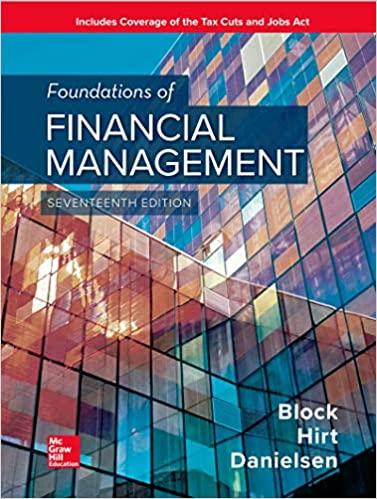Answered step by step
Verified Expert Solution
Question
1 Approved Answer
Investment Exercise Case Study Kate and Max are a young newlywed couple. Max is an electrician working for the city, and Kate is a supply
Investment Exercise Case Study
Kate and Max are a young newlywed couple. Max is an electrician working for the city, and Kate is a supply chain manager in an energy firm. Their current combined net income is $ per year.
Kate and Max were recently talking about their desire to start a family within the next three years. While they are happy with how their careers and income have progressed so far, they realize they need to take control of their financial life if they want to start a family.
After completing a Cash Flow analysis, developing a budget, implementing some sound money management practices and ensuring they have proper insurance, Max and Kate realize the next step in building their financial plan is to create an Investment Plan so they can achieve their financial goals.
Purchase their home before the birth of their first child. They would like to buy the home in two years. They have friends who just purchased their home and know they will need $ for a down payment on a $ home. Kate remembers learning about the benefits of using the Home Buyers plan to purchase your first home. She currently has $ in her Group RRSP account at work.
Vehicle: The couple currently gets by with one vehicle as Kate takes public transit to work due to the high cost of parking at her downtown office. However, they anticipate that they will need a second car when the baby is born in three years. They expect that they will buy a used vehicle for $in today's dollars
Education: Having graduated a few years ago from university where they took some Personal Finance class with some student loans, they know full well the cost of a university education. They would like to be able to pay the tuition costs for their children to attend university. They plan on having their child in years. They would like to start saving enough now, so that they have $ available to jump start their first child education savings when the child is born in years. They are aware that they cannot yet open an RESP, until the child is born, but they would still want to know how much in today's dollars they would need to contribute monthly to fund years of university starting in years, with an annual tuition cost of $including books and miscellaneous and assuming no other costs such as room and board the child will either be living at home or working on the side to pay for their room and board on campus. Use a inflation assumption.
Saving Effort: Lastly, they know that making all these savings will require an effort on their budget, and they would like that effort to not go over $ per month not including the future RESP savings, as that's only for info for now so they can still enjoy their quality of life. Calculate their total monthly saving to answer either:
a Yes: their total saving effort will be less than $ month
b No: their total saving effort will be more than $ month.
Financial Goals
Projected Rate of Return
Fill in the colored boxes in the table below, and round each amount to the dollar no decimals
tableGoaltableAmountNeededWhen,Current Amount,tableRequired MonthlySavingstableProjectedRate of ReturnAsset Allocation,Investment VehicleTVM Calc.,FVPVPMTShort Term Goals less than years Down paymenta Amount Needed,$b Invest current savings,$c Balance to fund,$d Monthly ContributionMedium Term Goals to years Vehiclee Amount Needed,$f Monthly ContributionLong Term Goals years Educationtableg Monthly contribution tosave $ in years$tableh Monthly contributionfor education For InfoTotal Monthly Saving Effort: $tableAnswer to Question : Yes: their total saving effort will be lessthan $ month
Note: Use monthly rate for monthly contribution
a Find the amount that will be needed in years for the down payment, knowing its current value of $ and the inflation rate.
b What will be the future value of current savings by then, when invested at RRSP rate?
c How much will th

Step by Step Solution
There are 3 Steps involved in it
Step: 1

Get Instant Access to Expert-Tailored Solutions
See step-by-step solutions with expert insights and AI powered tools for academic success
Step: 2

Step: 3

Ace Your Homework with AI
Get the answers you need in no time with our AI-driven, step-by-step assistance
Get Started


